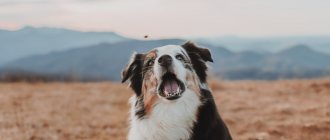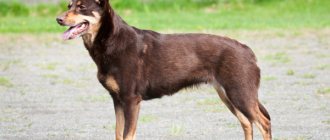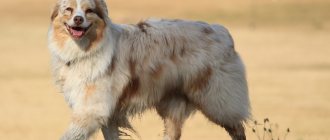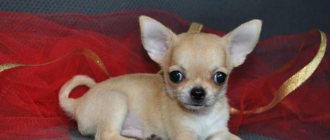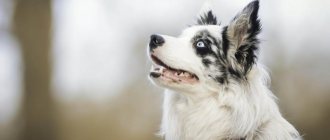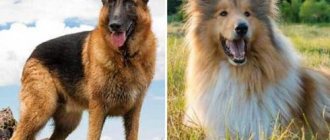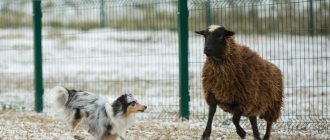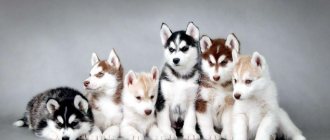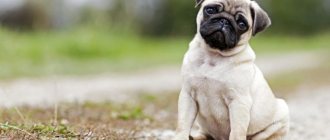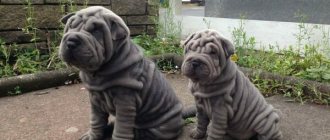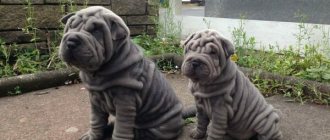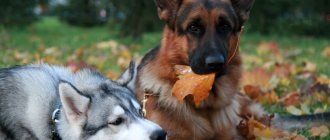The Mini Australian Shepherd today is better known as the Dwarf American Shepherd, because the breeding of these animals began to be actively pursued in the United States of America. It belongs to the breed of herding dogs and is practically not found in Russia. Nevertheless, interest in these funny dogs is growing, so it would be useful to talk about the breed.
Miniature Shepherd, also known as Mini Aussie
Origin story
The most famous breed in the world is the German Shepherd. But few people know about the Aussie (miniature Australian Shepherd). It occurred as a result of crossing varieties of collie, Pyrenean Shepherd, and Bernese Mountain Dog. However, the current name of the species is in no way connected with the names of the ancestors.
America is considered the birthplace of mini-shepherds. The appearance of this breed in the American club occurred in 1980. From that moment on, the animals began to quickly spread throughout the world, and gained enormous popularity in their homeland.
Possible diseases
The Australian Dwarf Shepherd is susceptible to developing diseases that have a hereditary etiology. Acquired conditions are diagnosed less frequently. For the most part, these are diseases that occur in the standard breed:
- associated with the visual system (retinal atrophy, etc.);
- related to the musculoskeletal system (hip dysplasia, etc.);
- having a neurogenic nature (myelopathy, etc.).
If you do not engage in animal sports and limit your pet to nutritious food, it increases the risk of developing obesity.
Description and characteristics
The Mini Australian Shepherd is a herding dog. Thanks to her high intelligence, she effectively and without problems performs the functions assigned to her.
The following points should be noted in the description of the breed:
- head is strong. It is proportional to the rest of the body;
- powerful neck;
- medium ears, which are practically in an erect position. Only the tips droop a little;
- almond-shaped eyes that have different shades: marble, speckled, blue, etc.;
- nose black or lighter. Its color depends on the color of the pet;
- scissor bite;
- the tail is straight. At birth it can be stopped;
- oval paws.
The body of these dogs is flexible and well-developed muscles. The stomach is tucked. The animal is covered with moderately coarse hair. Its length is average. The color of a dog can be varied. Spotted colors are common.
Related article: All the main characteristics of the Anatolian Shepherd
The dwarf shepherd dog of this variety weighs on average about 32 kg. Height at the withers usually reaches 58 cm. Life expectancy is approximately 13 years.
Dimensions
It is almost impossible to detect a pituitary dwarfism defect in newborn puppies. After all, it begins to manifest itself only when the dogs are 2-2.5 months old. At this time, they begin to differ from their brothers and sisters by significant growth retardation. At one month, these animals generally look like very thoroughbreds: they have a massive head and a short muzzle. And at 2 months, dwarf animals have a short neck, which should also alarm the owner.
An adult Dwarf German Shepherd weighs between 10 and 15 kilograms (while a regular German Shepherd weighs between 27 and 35 kilograms). The dog's height reaches 50 centimeters. Weaker animals grow only up to 40 centimeters. A dog has this size at 5-6 months of its life.
Character and education
Australian Aussies have a friendly and affectionate personality. They are loyal friends and very smart pets. You can't hear them barking for no reason. A distinctive character trait is that dogs try to do everything so that their owner is satisfied.
Dwarf Australian Shepherds get along well with their relatives. Especially if they grew up together. Like the German Shepherd, they get along well with people, including children.
Dogs of this variety prefer noisy and active games. However, one cannot expect them to be friendly towards strangers and animals. Although even in this case it does not reach the point of open aggression. But in this case, the dogs begin to more actively protect the owner and the territory.
Due to their high intelligence, these animals are easy to train. They can easily remember the commands the first time. When raising this breed, you need to remember about its high energy. Therefore, if the dog will not be used on pasture, then it needs to find another use. In the city, frequent walks and exercises will help you cope with irrepressible energy. Moreover, puppies are more active than adults, so you will have to tinker with them more.
In apartment conditions, these dogs often suffer from loneliness, which results in chewed shoes, furniture and wires. To avoid such unpleasant moments, you also need to know how to properly maintain this breed.
Buying a puppy
You need to buy a purebred puppy only from trusted nurseries, since unscrupulous breeders, for the sake of profit, can use animals with breed defects or use inbreeding - inbreeding.
Puppies obtained from such matings are often born sick and carry defective genes into subsequent generations.
The price of a Schipperke puppy varies depending on the breed value of the parents and the class of the puppy itself. You can buy a pet-class Schipperke for 10,000 rubles, a breed-class animal will cost 35,000 rubles, and for a show-class pet you will have to pay at least 70 thousand rubles.
Maintenance and care
One of the main advantages of the breed is its beautiful and thick coat. In order for it to continue to remain this way, it is necessary to care for it correctly. Every day the dog should be combed with a comb equipped with stiff bristles. This will avoid the formation of tangles.
Similar article: All the most interesting things about the Polish Podgalian Shepherd Dog
Ear cleaning is a must. For these purposes, a cotton swab and a special lotion are used. The cleaning procedure is performed once a week. The eyes are also cleaned. It is best to wipe them with chamomile infusion or weak tea.
Animals should have their nails trimmed periodically. A special nail clipper is sold for these purposes. After each walk, you should check your paws in order to detect cracks in time and treat them with vegetable oil.
Despite their thick coats, Miniature Australian Shepherds do not often need to be bathed. It is enough to carry out water procedures once a month. But the shampoo you choose must be suitable for your pet’s specific coat type.
Animals must have their teeth brushed. There is a special toothbrush for these purposes. This procedure is carried out twice a week.
It is not recommended to cut dogs' hair, as sunlight has a negative effect on their skin. It is worth noting that animals with a red tint do not tolerate heat and scorching sun. Therefore, in summer they need to be walked in a shady area.
It is best to keep dwarf shepherds in the private sector or in rural areas. If they live in apartments, then frequent walking is necessary.
Health
As for the health of dwarf shepherd dogs, it is very weakened. The main problems that may arise in representatives of this breed subtype are the following:
- Colds
- sterility
- Renal dysfunction
- Thyroid dysfunction
- Bacterial infections
- Hair loss
- Hyperpigmentation
- Allergy
- Pneumonia
Your pet should receive comprehensive vaccinations against distemper, eneritis, worms, hepatitis and influenza. This must be done within the first 2 months of the dog's life. It is also necessary to get a rabies vaccination in the first 12 weeks after the birth of the animal.
In addition, puppies need additional injections of growth hormone and thyroid hormone. But this should be done very carefully and only in a veterinary clinic.
It is important to remember that dogs of the German Dwarf Shepherd breed require constant and serious supervision, both from the owner and from veterinarians.
Features of feeding
For dogs of this breed, the daily diet should include both natural food and dry food. Moreover, if you buy dry food, it should be premium. Natural products are given to pets along with vitamin supplements.
The following foods can be fed to Miniature Australian Shepherds:
- meat: rabbit, beef, chicken;
- offal;
- vegetables: zucchini, carrots, broccoli, etc.;
- dairy products (kefir, cottage cheese);
- boiled egg. Given once a week;
- boiled sea fish. Boneless varieties are selected;
- vegetable oil (1 tsp once a day).
The diet is selected depending on the age of the dog. Up to 2 months you need to feed 5 times a day. Two meals a day are introduced from 7 months.
It is strictly forbidden to give dogs of this breed flour, spicy and fried foods, pork, chicken bones, sour cream and sweets.
Training
The Mini Shepherd is easy to train due to its devotion to its owner. She is interested in following commands and feeling loved and appreciated.
Of course, in order for your pet to learn good behavior and commands faster, you can give it to a professional trainer. But it’s still better to train directly at home. This way the animal will become more attached to the person and will enjoy the process. To begin with, 30 minutes a day is enough to teach your pet commands and service. After all, the German Shepherd has high learning abilities. You can start training when the animal is already 2 months old.
Video “All about the Australian Shepherd Aussie”
From this video you will learn the details of the popular Aussie Shepherd breed.
Recommended Posts
Standard height and weight of the Cane Corso breed by month
Weight of a puppy and an adult Labrador by month
Weight and height of a German Shepherd puppy by month
38 best dog breeds for apartments according to reviews from breeders and owners
Description and content of the hunting border terrier
TOP 40 best hunting dog breeds with names, descriptions and photos
Is the Miniature Shepherd a breed or a genetic defect?
If we consider the Dwarf German Shepherd from a scientific point of view, then such a dog is not a separate breed. Many dog breeders and dog handlers believe that this is simply a smaller copy of the German Shepherd. Representatives of this breed are miniature in size due to a genetic disease inherited from parents . It is called pituitary dwarfism syndrome.
Pituitary dwarfism syndrome occurs due to a lack of growth hormone in the body. The dog's pituitary gland simply cannot produce it. This defect is very common in shepherds. Most often it occurs due to the fact that both parents had mutant genes that were passed on in a recessive manner. That is, dwarfism can appear in 25 percent of cases.
Akita training
Akita is very stubborn when training and training such a pet is difficult and takes a long time. Such dogs will not easily carry out what their owner commands, since they have their own opinion on every action.
When training, you will have to spend a lot of effort and time, and for the owner this will be a real test that only a person who truly wants to have a dog can pass.
It is best to turn all your Akita training into a fun and interesting game. In addition, it is necessary to accurately understand the mood and desires of your pet in order to cope with all his stubbornness.
As soon as the dog is tired and stops showing interest in what is happening, try to entice him with a treat or toy and be sure to give him a break. These traits are visible when reading the characteristics of the American Akita breed.
Miniature American Shepherd, up to 45 cm
The miniature American Shepherd resembles an Aussie in appearance. This is not surprising, since it was bred in the 60s by crossing Australians with an unknown small dog. This was done not so much on a whim, but rather with the goal of reducing the size of the Aussies, but preserving their intelligence, service qualities and character traits.
The new breed was officially recognized in 2010. The American Shepherd turned out the way it was intended: miniature, but strong, hardy, with a good nervous system. The coat can be white and black, white and red, with or without tan marks, with or without white markings - in general, the dog has a wide variety of colors.
Interesting Facts
- These shepherds are able to surprise with a rare feature - they move through trees. In the middle of the last century, advertising brochures were published in the USA, where this extraordinary dog was depicted climbing a tree after some animal. At the bottom there was a caption: “An English Shepherd will get anything and anyone even from a tree.”
- In Russia and the countries of the former CIS, the English Shepherd appeared towards the end of the 90s of the last century, but has not yet achieved great popularity. It is not included in the RKF classification. However, a suitable nursery can be found. For example, in Moscow, Kyiv and Minsk.
- These dogs are allergic to medications for a reason. Recent research at Washington State University has shown that 15% of all English Shepherds may have a disorder in the MDR1 (membrane protein, glycoprotein) gene. This results in an inappropriate response to some medications used to treat dogs. The consequence may be impaired movement, coordination, trembling, vomiting, disorientation, even death of the animal. A simple cheek swab test is required to test for the mutation.
- To better imagine what the character of the English Shepherd is, you can recall the film “Shaggy Christmas Trees”. There, one of the characters, the dog Pirate, is played by a border collie. Loyalty, dedication, affection, ingenuity, endurance - all these qualities were passed on from the “Scots” to their descendants, the English Shepherds.
Greek, up to 35 cm
This shepherd was bred in the mountainous regions of Greece to help shepherds look after their livestock. This is primarily a service dog, hardy and unpretentious. During training, consistency and rigor are required; the shepherd dog does not respond well to cruelty. But if a person is lucky enough to become a real master for her, then she will be faithful to him all her life.
The Greek Shepherd is a medium breed, it has a strong, muscular body, white, gray and black coat. The main goal was to obtain service qualities, so the color is not so important and the most diverse is found.
Icelandic, 45 cm
This strong miniature white and red dog immediately wins everyone's sympathy. She has thick fur, short paws and a curled fluffy tail - a definitely touching combination.
Meanwhile, this is a very hardy, smart and non-aggressive dog that has lived in Iceland for centuries. She arrived on the island along with the first settlers, the Vikings, around the first century AD, and survived side by side with people in harsh conditions.
This is a herding breed with all its inherent character traits. She has a loud bark, which is very useful when grazing livestock, but will interfere with establishing relationships with neighbors. Therefore, the Icelandic Shepherd with relative freedom and a lot of mobility.
Schipperke, up to 30 cm
Miniature jet-black dogs invariably cause a lot of affection, but they are quite independent and proud dogs. They were bred in Belgium in the 19th century to hunt rats and mice.
Schipperke do not exceed 30 cm, weight ranges from 3-9 kg. The fur is black, shiny, triangular ears stand up, and the chest is decorated with a lush “collar”. Dogs cannot live normally without active communication, sports and frequent walks, so with homebodies and introverts they will only torment each other.
